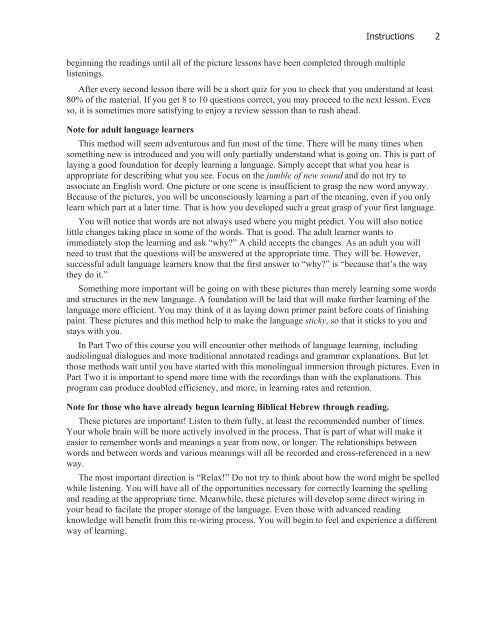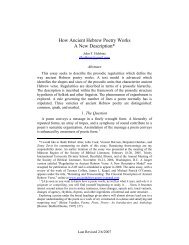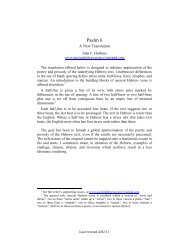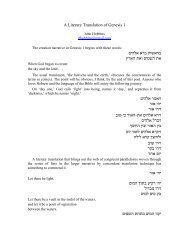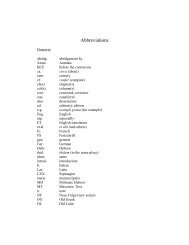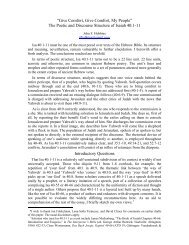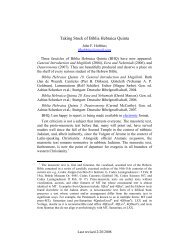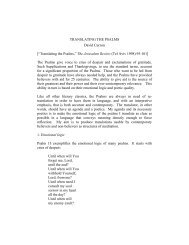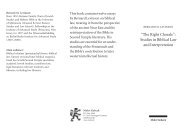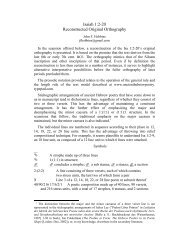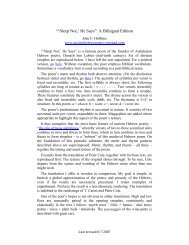Living Biblical Hebrew - Ancient Hebrew Poetry
Living Biblical Hebrew - Ancient Hebrew Poetry
Living Biblical Hebrew - Ancient Hebrew Poetry
You also want an ePaper? Increase the reach of your titles
YUMPU automatically turns print PDFs into web optimized ePapers that Google loves.
Instructions 2beginning the readings until all of the picture lessons have been completed through multiplelistenings.After every second lesson there will be a short quiz for you to check that you understand at least80% of the material. If you get 8 to 10 questions correct, you may proceed to the next lesson. Evenso, it is sometimes more satisfying to enjoy a review session than to rush ahead.Note for adult language learnersThis method will seem adventurous and fun most of the time. There will be many times whensomething new is introduced and you will only partially understand what is going on. This is part oflaying a good foundation for deeply learning a language. Simply accept that what you hear isappropriate for describing what you see. Focus on the jumble of new sound and do not try toassociate an English word. One picture or one scene is insufficient to grasp the new word anyway.Because of the pictures, you will be unconsciously learning a part of the meaning, even if you onlylearn which part at a later time. That is how you developed such a great grasp of your first language.You will notice that words are not always used where you might predict. You will also noticelittle changes taking place in some of the words. That is good. The adult learner wants toimmediately stop the learning and ask “why?” A child accepts the changes. As an adult you willneed to trust that the questions will be answered at the appropriate time. They will be. However,successful adult language learners know that the first answer to “why?” is “because that’s the waythey do it.”Something more important will be going on with these pictures than merely learning some wordsand structures in the new language. A foundation will be laid that will make further learning of thelanguage more efficient. You may think of it as laying down primer paint before coats of finishingpaint. These pictures and this method help to make the language sticky, so that it sticks to you andstays with you.In Part Two of this course you will encounter other methods of language learning, includingaudiolingual dialogues and more traditional annotated readings and grammar explanations. But letthose methods wait until you have started with this monolingual immersion through pictures. Even inPart Two it is important to spend more time with the recordings than with the explanations. Thisprogram can produce doubled efficiency, and more, in learning rates and retention.Note for those who have already begun learning <strong>Biblical</strong> <strong>Hebrew</strong> through reading.These pictures are important! Listen to them fully, at least the recommended number of times.Your whole brain will be more actively involved in the process. That is part of what will make iteasier to remember words and meanings a year from now, or longer. The relationships betweenwords and between words and various meanings will all be recorded and cross-referenced in a newway.The most important direction is “Relax!” Do not try to think about how the word might be spelledwhile listening. You will have all of the opportunities necessary for correctly learning the spellingand reading at the appropriate time. Meanwhile, these pictures will develop some direct wiring inyour head to facilate the proper storage of the language. Even those with advanced readingknowledge will benefit from this re-wiring process. You will begin to feel and experience a differentway of learning.


